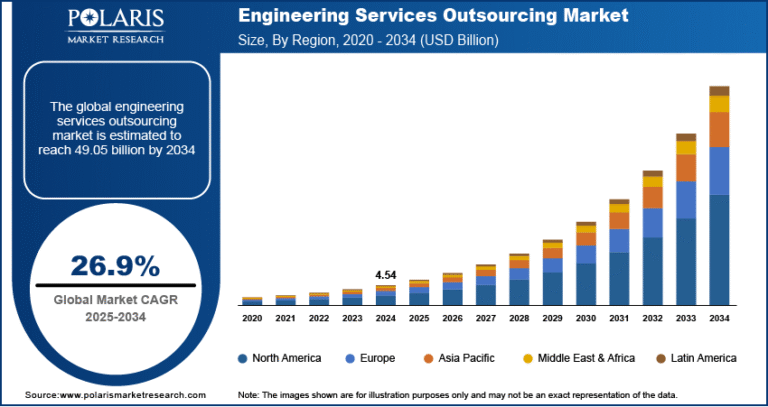5G Infrastructure Market Expected to Reach USD 161.61 Billion by 2034, Growing at a CAGR of 29.5%

📡 Market Overview
The 5G infrastructure market encompasses essential components such as macro and small cell base stations, radios, antennas, fiber backhaul, network routers, switches, and core network equipment. As telecommunications operators transition from 4G to 5G, they aim to support ultra-low latency, massive device connectivity, and high data throughput. This infrastructure upgrade enables a range of advanced use cases including ultra-high-definition (UHD) video streaming, augmented reality (AR), industrial IoT, autonomous vehicles, and smart city applications.
Key Trends & Insights
-
Expansion of Small Cells and Densification
-
To deliver reliable high-speed service and enhanced indoor coverage, operators are investing heavily in small cell rollout—especially in urban areas, stadiums, and transit hubs.
-
-
Open RAN (O-RAN) Adoption
-
There is a growing move toward open and disaggregated network architectures that promote interoperability, multi-vendor ecosystems, and reduced costs. Telecom providers globally are conducting pilot programs and commercial trials with O-RAN infrastructure.
-
-
Edge Computing Integration
-
The integration of Multi-access Edge Computing (MEC) into 5G infrastructure enables localized data processing, reducing latency for real-time applications in manufacturing, gaming, and autonomous systems.
-
-
mmWave and Massive MIMO Rollouts
-
Operators are launching mmWave networks and massive Multiple Input, Multiple Output (MIMO) antenna systems to achieve gigabit-speed data transmission and better spectral efficiency.
-
-
Focus on Energy Efficiency
-
As energy consumption rises with network expansion, manufacturers and operators are incorporating green features—such as AI-driven power optimization and energy-efficient hardware—to minimize operating expenses and carbon footprint.
-
Market Size & Forecast
Market size value in 2025 USD – 15.78 billion
Revenue forecast in 2034 USD – 161.61 billion
CAGR – 29.5% from 2025 – 2034
Request for Free Sample: https://www.polarismarketresearch.com/industry-analysis/5g-infrastructure-market/request-for-sample
Key Market Growth Drivers
-
Rising Demand for High-Speed Connectivity
-
Consumer and enterprise appetite for faster, more reliable broadband is fueling rapid 5G network investment.
-
-
Industrial Use Cases
-
Critical applications in smart manufacturing, remote healthcare, autonomous transport, and logistics are catalyzing commercial deployment of 5G-enabled systems.
-
-
Regulatory Support and Spectrum Allocation
-
Governments are offering incentives, streamlined licensing, and dedicated mid-to-high band spectrum auctions to accelerate 5G rollout.
-
-
Telecom Network Upgrades
-
Legacy network operators are investing in 5G as part of multi-year plans to modernize infrastructure with 4G-5G integration and seamless migration paths.
-
-
Private 5G Initiatives
-
Enterprises across manufacturing, mining, ports, education, and healthcare are launching private 5G networks to support secure, localized connectivity for their operations.
-
Market Challenges
-
High Infrastructure and Deployment Costs
-
Massive rollout of densified networks, especially in urban and private industrial environments, requires substantial capital investment.
-
-
Complexity in Deployment & Integration
-
Integrating heterogeneous network components (macro, small cell, edge, cloud) across multiple vendors increases technological and operational complexity.
-
-
Spectrum Fragmentation
-
Operators often face delays or regulatory barriers in securing contiguous mid and high-band spectrum, impacting rollout pace and performance.
-
-
Security & Privacy Concerns
-
The distributed and software-driven architecture of a 5G network surface potential vulnerabilities, necessitating strong cybersecurity measures.
-
-
Skilled Workforce Shortage
-
Deployment, maintenance, and managing modern, virtualized network infrastructure requires highly skilled engineers—an area where talent is in short supply.
-
Summary
The 5G infrastructure market is set for strong growth over the next decade, propelled by global digitization, enterprise use cases, cloud-edge integration, and public-private deployment strategies. Despite challenges around cost, rollout complexity, spectrum procurement, and cybersecurity, the shift toward open architectures, energy-efficient solutions, and private network adoption offers long-term opportunity.






